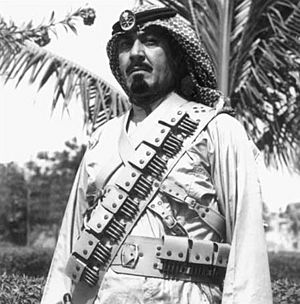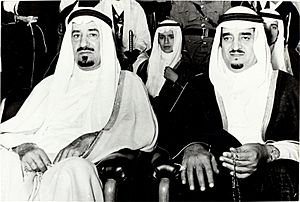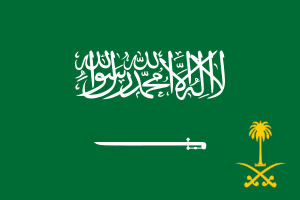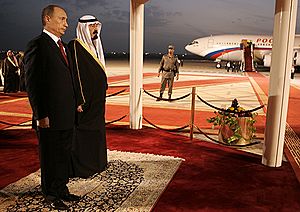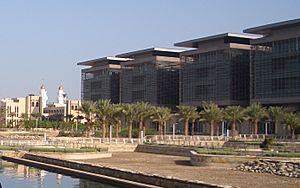Abdullah of Saudi Arabia facts for kids
Quick facts for kids Abdullah |
|||||
|---|---|---|---|---|---|
| Custodian of the Two Holy Mosques | |||||
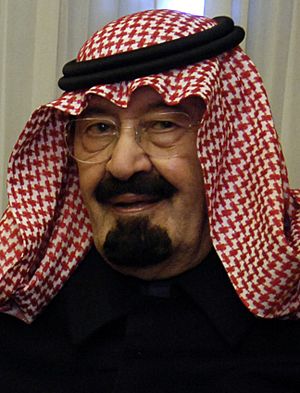
King Abdullah in 2007
|
|||||
| King and Prime Minister of Saudi Arabia | |||||
| Reign | 1 August 2005 – 23 January 2015 | ||||
| Bay'ah | 2 August 2005 | ||||
| Predecessor | Fahd | ||||
| Successor | Salman | ||||
| Regent of Saudi Arabia (Due to King Fahd's illness) |
|||||
| Tenure | 1 January 1996 – 1 August 2005 | ||||
| Crown Prince of Saudi Arabia First Deputy Prime Minister |
|||||
| Tenure | 13 June 1982 – 1 August 2005 | ||||
|
Monarch
|
Fahd
|
||||
|
Prime Minister
|
King Fahd
|
||||
| Predecessor | Fahd bin Abdulaziz | ||||
| Successor | Sultan bin Abdulaziz | ||||
| Second Deputy Prime Minister of Saudi Arabia | |||||
| Tenure | 25 April 1975 – 13 June 1982 | ||||
|
Monarch
|
|||||
|
Prime Minister
|
King Khalid
|
||||
| Predecessor | Fahd bin Abdulaziz | ||||
| Successor | Sultan bin Abdulaziz | ||||
| Commander of the National Guard | |||||
| Tenure | 1963–2010 | ||||
|
Monarch
|
|||||
| Predecessor | Saad bin Saud | ||||
| Successor | Mutaib bin Abdullah | ||||
| Born | 1 August 1924 Riyadh, Nejd |
||||
| Died | 23 January 2015 (aged 90) Riyadh, Saudi Arabia |
||||
| Burial | 23 January 2015 Al Oud cemetery, Riyadh |
||||
| Spouse |
List
Al Anoud Al Fayez (1972–2003; divorced)
Jawahir bint Ali Hussein Aida Fustuq (divorced) Munira Al Otaishan Munira bint Abdullah Al Al Shaykh Tathi bint Mishan al Faisal al Jarba Hessa bint Trad Al Shaalan (23 or more other wives) |
||||
| Issue Detail |
List
Prince Khalid
Prince Mutaib Prince Faisal Prince Abdulaziz Prince Mishaal Prince Turki Prince Saud Prince Mansour Prince Badr Princess Noura Princess Aliya Princess Adila Princess Abeer Princess Maryam Princess Sahab Princess Sahar Princess Maha Princess Hala Princess Jawahir Princess Anoud Prince Mohammed Prince Majed Prince Saud Prince Bandar |
||||
|
|||||
| House | House of Saud | ||||
| Father | Abdulaziz of Saudi Arabia | ||||
| Mother | Fahda bint Asi Al Shuraim | ||||
Abdullah bin Abdulaziz Al Saud (born 1 August 1924 – died 23 January 2015) was the King and Prime Minister of Saudi Arabia from 2005 until his death in 2015. Before becoming king, he was the Crown Prince of Saudi Arabia starting in 1982. He was the tenth son of King Abdulaziz, who founded Saudi Arabia. Abdullah was one of six sons of King Abdulaziz who later became kings.
Abdullah's mother was Fahda bint Asi Al Shuraim. She was from the Al Rashid dynasty, which had been rivals of the Al Saud family in the past. Abdullah held important government jobs for most of his life. In 1961, he became the mayor of Mecca. The next year, he was put in charge of the Saudi Arabian National Guard, a role he kept even after becoming king. He also served as a deputy defense minister. When his half-brother Fahd became king in 1982, Abdullah was named crown prince. After King Fahd became very ill in 1995, Abdullah became the actual ruler of Saudi Arabia for ten years before officially becoming king.
As king, Abdullah kept strong ties with countries like the United States and the United Kingdom. He bought a lot of defense equipment from them. He also made important changes, like giving women the right to vote in local elections and allowing them to compete in the Olympics. During the Arab Spring protests, he kept things stable in Saudi Arabia.
Contents
Early Life
Abdullah was born on 1 August 1924 in Riyadh. He was the tenth son of King Abdulaziz. His mother, Fahda bint Asi Al Shuraim, was from the Al Rashid family. This family was a long-time rival of the Al Saud family. She was from the powerful Shammar tribe. Abdullah's mother passed away when he was six years old.
Becoming a Leader
In 1963, Abdullah became the commander of the Saudi National Guard. This was an important position that helped him gain influence within the royal family. Under his leadership, the National Guard became a modern military force.
Second in Line
In 1975, King Khalid appointed Abdullah as the second deputy prime minister. This showed his important place in the line to the throne. He became the third most powerful person in the Saudi government. Abdullah kept his role as head of the National Guard, which was a key part of his power.
Crown Prince and Regent
When King Khalid died in 1982, Fahd bin Abdulaziz became King. Abdullah then became the Crown Prince and continued to lead the National Guard. As crown prince, Abdullah was known for bringing different groups of princes together. His control over the National Guard was very important to his success.
In 1995, King Fahd became seriously ill. Crown Prince Abdullah then took over as the de facto (actual) ruler of Saudi Arabia. He managed the country's affairs for ten years until King Fahd's death.
In 2002, Abdullah created the Arab Peace Initiative. This plan aimed to find a peaceful solution to the conflict between Arabs and Israelis. The plan was accepted by the Arab League in March 2002.
King of Saudi Arabia
Abdullah became king when his half-brother King Fahd passed away. He officially took the throne on 2 August 2005.
Important Changes as King
Abdullah's government tried to make many improvements in Saudi Arabia.
Education and Development
In 2005, King Abdullah started a government program to send young Saudi men and women to study at universities around the world. This program helped over 70,000 Saudis study abroad. He also invested in educating the workforce for future jobs.
He opened the King Abdullah University of Science and Technology (KAUST). This university is a major center for scientific research and is known for being co-ed (allowing both male and female students).
Social Reforms
In 2005, Abdullah made the country's national day (23 September) a public holiday. This was a step to reduce the influence of some strict religious rules.
In 2009, he changed the leadership of the education ministry. He appointed Nora al-Fayez, a U.S.-educated teacher, as deputy education minister for female students. This was a big step for women in education.
In 2011, during the Arab Spring protests, King Abdullah announced that women would have the right to vote in the 2015 municipal council elections. This was a major reform. He also said that women could join the unelected shura (advisory council).
In 2012, Saudi Arabia announced that its women athletes could compete in the Olympics for the first time. This decision ended questions about gender discrimination in sports.
In 2013, the Saudi government approved a law that made domestic violence a crime. This law included punishments like prison time and fines for abuse.
Religious Dialogue
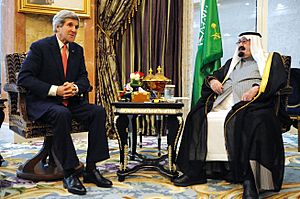
King Abdullah worked to promote understanding between different religions. In 2007, he visited Pope Benedict XVI, becoming the first Saudi monarch to do so. In 2008, he called for honest discussions between followers of all religions. He held a conference in Mecca to encourage Muslim leaders to talk with Jewish and Christian leaders. This led to the World Interfaith Harmony Week.
In 2011, an agreement was signed to create the Abdullah bin Abdulaziz International Centre for Interreligious and Intercultural Dialogue in Vienna. This center officially opened in 2012.
Working with Other Countries
United States
Abdullah was a strong ally of the United States. He visited the US many times, meeting with presidents like Gerald Ford, Bill Clinton, George W. Bush, and Barack Obama. He believed that the friendship between the two countries was very important.
Iraq
King Abdullah did not trust Iraqi Prime Minister Nouri al-Maliki. He hoped for better relations between Saudi Arabia and Iraq in the future. In 2014, when the Islamic State of Iraq and the Levant (ISIL) spread, he spoke out against them. He called on Islamic leaders to fight against those who try to make Islam seem like a religion of hate and terrorism.
Iran
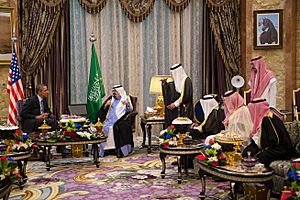
Abdullah had concerns about Iran's actions in the region and its nuclear program. He believed Iran was trying to cause problems in Arab countries.
China
Since Abdullah's visit to Beijing in 2006, Saudi Arabia and China have focused on energy and trade. Trade between the two countries grew a lot. Saudi Arabia also made large investments in China.
Other Nations
Abdullah visited Turkey in 2006, being the first Saudi king to make an official visit there. He also supported renewed diplomatic relations with Syria and its president, Bashar al-Assad, meeting him in 2009. However, relations worsened due to the Syrian Civil War, and Saudi Arabia closed its embassy in Damascus in 2011.
In 2011, Abdullah called for the Gulf Cooperation Council (GCC) to become a united "single entity" to protect national security.
Succession to the Throne
Abdullah's chosen successor was his half-brother Crown Prince Sultan until Sultan's death in 2011. Then, Sultan's full-brother, Nayef, became Crown Prince until he died in 2012. Finally, Abdullah named his half-brother Salman as Crown Prince. Salman became king after Abdullah's death in 2015.
In 2006, Abdullah created the Allegiance Council. This group, made up of sons and grandsons of Saudi Arabia's founder, votes to choose future kings and crown princes.
Various Positions
Abdullah was the Commander of the Saudi National Guard from 1963 to 2010. He was also the Chairman of the Saudi Supreme Economic Council until 2009. He held other important roles, including President of the High Council for Petroleum and Minerals, and head of the Military Service Council.
Personal Life

King Abdullah had many children. His family members, including his wives, grandchildren, and great-grandchildren, have faced travel restrictions since 2017.
Wives and Children
Abdullah had around 30 wives and fathered 36 children, including 16 sons and 20 daughters.
Some of his notable children include:
- Prince Mutaib, who was a former commander and minister of the National Guard.
- Prince Abdulaziz, who was a deputy foreign affairs minister.
- Princess Adila, who is known for supporting women's rights, including the right to drive.
- Princess Sahab, who married the son of the King of Bahrain.
- Princess Hala, who passed away in 2021.
Four of his daughters from a previous marriage, Sahar, Maha, Hala, and Jawahir, were under house arrest for several years and were not allowed to leave the country.
Illness and Death
From 2010 to 2012, King Abdullah had four back surgeries. His health problems became more noticeable. In January 2015, he was hospitalized for pneumonia and passed away on 23 January at the age of 90.
Following Islamic tradition, his funeral was held on the same day at the Grand Mosque of Riyadh. He was buried in an unmarked grave at the Al Oud cemetery. Three days of national mourning were declared in Saudi Arabia.
Influence
In 2012, Abdullah was named the most influential Muslim among 500 Muslims for four years in a row. Forbes magazine also listed him as the seventh most powerful person in the world in 2012.
Wealth
King Abdullah was one of the wealthiest monarchs in the world. In 2011, his wealth was estimated to be around US$21 billion.
He was skilled in horse riding in his youth. He owned very large stables with over 1,000 horses. He also owned a large farm complex called Janadria Farm near Riyadh.
King Abdullah was known for his generosity. In 2005, he paid for the surgery to separate Polish conjoined twins. He also donated $50 million and relief materials for the 2008 Sichuan earthquake in China. In 2008, he donated $10 billion to the King Abdullah University of Science and Technology.
Honours and Awards
| Styles of King Abdullah |
|
|---|---|
 |
|
| Reference style | Custodian of the Two Holy Mosques |
Abdullah received many international awards. In April 2012, the United Nations gave him a gold medal for his work in promoting understanding between cultures and peace.
Foreign Honours
- Honorary Grand Commander of the Order of Loyalty to the Crown of Malaysia (1982)
- Honorary Grand Commander of the Order of the Defender of the Realm (2003)
Images for kids
See Also
 In Spanish: Abdalá bin Abdulaziz para niños
In Spanish: Abdalá bin Abdulaziz para niños


